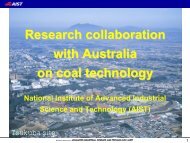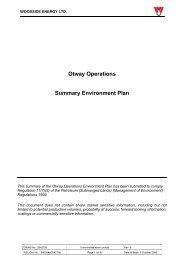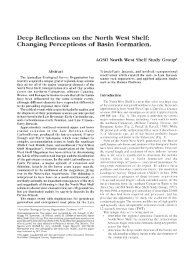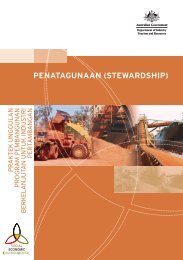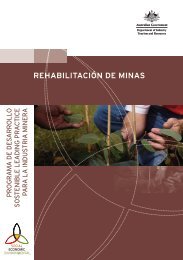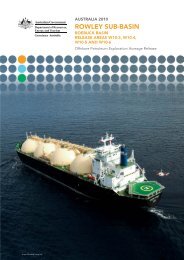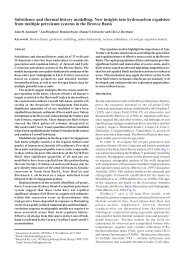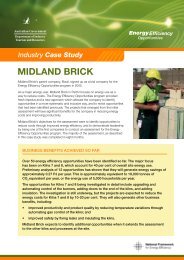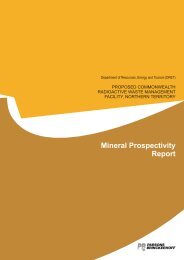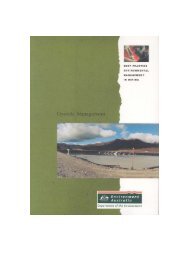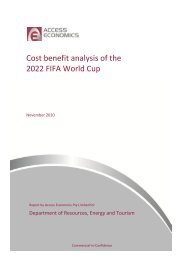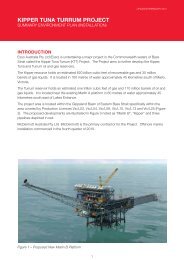A guide to leading practice sustainable development in mining
A guide to leading practice sustainable development in mining
A guide to leading practice sustainable development in mining
You also want an ePaper? Increase the reach of your titles
YUMPU automatically turns print PDFs into web optimized ePapers that Google loves.
MINE: Alcoa bauxite m<strong>in</strong>es<br />
LOCATION: Western Australia<br />
BRIEF DESCRIPTION: Surface bauxite m<strong>in</strong><strong>in</strong>g<br />
AREA OF LEADING PRACTICE: Tail<strong>in</strong>gs disposal; Rehabilitation; closure and<br />
completion<br />
HANDBOOK(S) REFERENCE: Tail<strong>in</strong>gs; M<strong>in</strong>e rehabilitation; m<strong>in</strong>e closure and<br />
completion<br />
DESCRIPTION OF INNOVATION:<br />
Alcoa World Alum<strong>in</strong>a Australia currently produces 7.3 million <strong>to</strong>nnes of<br />
alum<strong>in</strong>a annually at its Western Australian ref<strong>in</strong>eries located at Kw<strong>in</strong>ana,<br />
P<strong>in</strong>jarra, and Wagerup. These ref<strong>in</strong>eries utilise bauxite m<strong>in</strong>ed <strong>in</strong> the nearby<br />
Darl<strong>in</strong>g Range. This ore is low grade by world standards as two <strong>to</strong>nnes of<br />
residues are produced for every <strong>to</strong>nne of alum<strong>in</strong>a extracted.<br />
S<strong>to</strong>rage of this residue poses some major environmental challenges. The<br />
ref<strong>in</strong>eries are located close <strong>to</strong> major population centres and adjacent <strong>to</strong> some<br />
of the state’s most productive land, the volume of waste produced is very<br />
large, and the alkal<strong>in</strong>ity of the waste has the potential <strong>to</strong> impact valuable<br />
surface and ground water resources.<br />
There were a number of environmental and process reasons why the s<strong>to</strong>rage<br />
of low density “wet” tail<strong>in</strong>gs <strong>in</strong> large impoundments was not the preferred<br />
technique for future tail<strong>in</strong>gs s<strong>to</strong>rage. Development work began <strong>in</strong> the early<br />
1980s on alternative techniques and <strong>in</strong> 1985 “dry stack<strong>in</strong>g” was adopted<br />
for Alcoa’s Western Australian ref<strong>in</strong>eries. Dry stack<strong>in</strong>g utilises a large<br />
diameter Superthickener <strong>to</strong> de-water the f<strong>in</strong>e tail<strong>in</strong>gs, which is then spread<br />
<strong>in</strong> layers over the s<strong>to</strong>rage areas <strong>to</strong> de-water by a comb<strong>in</strong>ation of dra<strong>in</strong>age<br />
and evaporative dry<strong>in</strong>g. By utilis<strong>in</strong>g the coarse fraction of the tail<strong>in</strong>gs for<br />
construction of dra<strong>in</strong>age layers and upstream perimeter embankments, the<br />
s<strong>to</strong>rage area can be constructed as a progressive stack, thus avoid<strong>in</strong>g the<br />
need for full height perimeter dykes and allow<strong>in</strong>g cont<strong>in</strong>ued s<strong>to</strong>ckpil<strong>in</strong>g on<br />
areas which were previously “wet” impoundments.<br />
Rout<strong>in</strong>e plough<strong>in</strong>g of the mud with mechanical equipment has been termed<br />
“mud farm<strong>in</strong>g”. Mud farm<strong>in</strong>g helps achieve a maximum density which allows<br />
the dry stack <strong>to</strong> be developed with maximum outer slopes (a m<strong>in</strong>imum<br />
strength of 25kPa is achieved allow<strong>in</strong>g an outer slope of 6:1 <strong>to</strong> be ma<strong>in</strong>ta<strong>in</strong>ed),<br />
and maximises the s<strong>to</strong>rage efficiency of the stack.<br />
Mud farm<strong>in</strong>g also m<strong>in</strong>imises the potential for dust generation, which is<br />
important given the location of the ref<strong>in</strong>eries close <strong>to</strong> residential areas.<br />
Plough<strong>in</strong>g the surface presents a wet surface, buries carbonate, and provides<br />
a surface roughness that prevents dust lift-off once the tail<strong>in</strong>gs have dried.<br />
A GUIDE TO LEADING PRACTICE SUSTAINABLE DEVELOPMENT IN MINING 119



